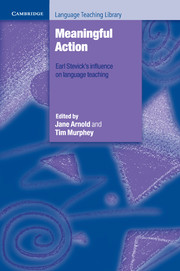Book contents
- Frontmatter
- Contents
- List of contributors
- Acknowledgements
- Preface
- Introduction
- Part A Meaning-making inside and between the people in the classroom
- Part B Meaningful classroom activity
- Part C Frameworks for meaningful language learning
- Epilogue: A way with words – perspectives on the contributions and influence of Earl W. Stevick
- Appendix: Words of tribute to Earl Stevick
- Index
10 - Communicative Language Teaching in the twenty-first century: the ‘Principled Communicative Approach’
Published online by Cambridge University Press: 15 November 2023
- Frontmatter
- Contents
- List of contributors
- Acknowledgements
- Preface
- Introduction
- Part A Meaning-making inside and between the people in the classroom
- Part B Meaningful classroom activity
- Part C Frameworks for meaningful language learning
- Epilogue: A way with words – perspectives on the contributions and influence of Earl W. Stevick
- Appendix: Words of tribute to Earl Stevick
- Index
Summary
Introduction
Earl Stevick has always been interested in improving language teaching methodology, and he has never been afraid of innovation. His seminal work, Teaching Languages: A Way and Ways (Stevick 1980), introduced many of us to Counselling-Learning and Suggestopedia for the first time, and in Memory, Meaning and Method: A View of Language Teaching. (Stevick 1996) he discussed a wide range of theoretical and practical considerations to help us better understand the intricate cognitive and interpersonal processes whereby a language is acquired and then used for meaningful communication. The proposal in this chapter to revitalize Communicative Language Teaching (CLT) in the light of contemporary scholarly advances is fully within the spirit of Earl's approach.
By the turn of the new millennium, CLT had become a real buzzword in language teaching methodology, but the extent to which the term covers a well-defined and uniform teaching method is highly questionable. In fact, since the genesis of CLT in the early 1970s, its proponents have developed a very wide range of variants that were only loosely related to each other (for overviews, see Savignon 2005; Spada 2007). In this chapter I first look at the core characteristics of CLT to explore the roots of the diverse interpretations and then argue that in order for CLT to fulfil all the expectations attached to it in the twenty-first century, the method needs to be revised according to the latest findings of psycholinguistic research. I will conclude the chapter by outlining the main principles of a proposed revised approach that I have termed the ‘Principled Communicative Approach’ (PCA).
The traditional communicative approach
Communicative Language Teaching was introduced at the beginning of the 1970s by British and American scholars to promote the teaching of usable communicative skills in L2 instruction. Although it was seen by many as a counter-reaction to the Audiolingual method that dominated the 1960s, the main goal of CLT – to develop a functional communicative L2 competence in the learners – was actually similar to the primary audiolingual objective. However, CLT pursued the communicative agenda in a radically different manner.
- Type
- Chapter
- Information
- Meaningful ActionEarl Stevick's Influence on Language Teaching, pp. 161 - 171Publisher: Cambridge University PressPrint publication year: 2013
- 6
- Cited by



